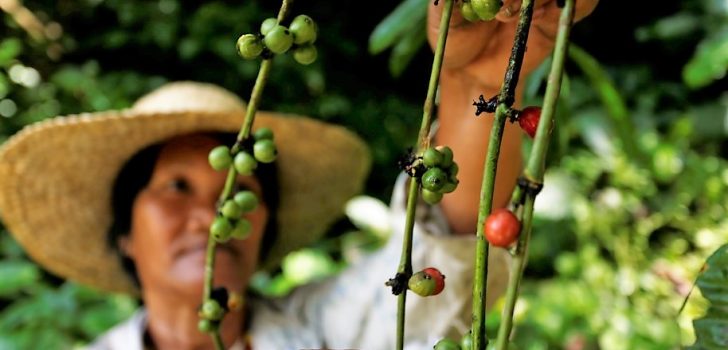
Revitalizing Kalinga’s coffee industry with PRDP – a legacy worth keeping
Out of happiness, Jerry Donga of Balawag, Tabuk City, Kalinga expressed his gratefulness for the improvement of the Bulanao to Amlao Farm-to-Market Road (FMR) alongside Chico River as a legacy that is worth keeping.
Dubbed as the rice granary of the Cordillera Administrative Region, Kalinga is also home to the Region’s best coffee blend businesses as it was once known for its lush coffee plantations because its weather conditions and humus-laden soils are ideal for cultivating coffee.
Coffee has always been the all-time favorite drink of the local populace and in the Cordillera as a whole. However, reports show that coffee production in Kalinga seemed to have dropped due to several factors.
The value chain analysis for coffee in Kalinga indicates that low productivity is the major constraint that hampers the coffee enterprise development. This can be attributed to high transportation cost of agricultural inputs to the farmers and outputs to the market due to poor access road condition.
As a result, farmers abandon their coffee plantations and focus more on producing other cash crops such as rice and corn. They are discouraged to maintain their coffee areas and develop potential areas to increase coffee harvests.
As most of these coffee plantations are located along the mountain and forest areas, it will also be a lot harder for farmers to tend to their coffee plantations due to lack of good access roads.
This occurrences may have prompted the provincial government and coffee stakeholders to readily accept the selection of coffee as the priority commodity for Kalinga to be supported under the Department of Agriculture’s Philippine Rural Development Project (DA-PRDP).
As Cordillera’s second city, Tabuk holds so much promise for agro development, given its fertile lowlands watered by the Chico River that serve as steady source of water for its production areas according to Cordillera Almanac.
The city ranked second next to Tanudan which is the top coffee producing municipality in the province. This was based from the criteria set by the PRDP which included the consideration of coffee production area and volume of production, poverty incidence among others.
With the formulation of the province’s Provincial Commodity Investment Plan (PCIP), the improvement of Banneng to Gombowoy FMR in Tanudan was the first subproject to be implemented being the top coffee producing municipality in Kalinga. It was followed by the improvement of Bulanao to Amlao FMR in Tabuk City. The former was opened in February of this year and was officially turned over a month later.
The Bulanao to Amlao FMR was finally opened in a ceremony held on July 18, 2018, two years after its groundbreaking ceremony.
A farmer from barangay Amlao said before, that it was hard for them to transport their products to the market area in Bulanao due to the poor road condition.
Especially for the people residing towards the end of the subproject, they had to endure long walks through the muddy road until they reach the area where the road is accessible and transportation is available. During rainy season, residents would even cross over the Chico River to go back and forth their homes.
Tribal Council Elder Ignacio Baglingit, recalled in his message during the ceremonial opening for the Bulanao-Amlao FMR, the difficulty of their lives in barangay Amlao before the road even existed. He fervently described how the residents in the riverside lived with their situation way back in the 70s, 80s, and 90s as the road gets rerouted from one course to another.
The Bulanao to Amlao FMR is a 15.8-kilometer rural access road covering barangay Malin-awa, Balawag, Amlao, Suyang, and Lucog.
Rice, corn, coffee, banana, root crops, and other vegetables thrive along the area and at the end of the subproject sits a coffee forested hillside.
The concreting of the road has improved the situation before and has opened opportunities for business establishments and traders as well. Residents have claimed that various retailers that has not gone to their places before has now reached them. The travel time was also lessened and there is no longer hassle in bringing their agricultural produce to the center market area.
The FMR has a total project cost of P213, 041, 140.19 shared by the World Bank (80%), the Government of the Philippines through the DA (10%), and the LGU (10%).
In connection to the FMR, an enterprise development subproject was also initiated to boost the Kalinga coffee industry. This is the Kalinga Integrated Coffee Processing and Marketing Enterprise that is managed by the Kalinga Coffee Cluster Agricultural Cooperative (KCCAC).
It was conceptualized in response to the need for alternative buyers and market expansion that will give higher income to coffee grower members and Kalinga Coffee Cluster affiliates.
The Coffee Enterprise has a total investment cost of P14, 804,033.33 including the construction of the Kalinga Coffee Trading Center (KCTC) that was also inaugurated last July 18.
Aside from these, Kalinga has two more FMR subprojects in support to the coffee industry in the province.
Connectivity remains a challenge to community development and to the coffee enterprise in Kalinga. But with the interventions of the PRDP, the socio economic conditions in the community it serves will progress and eventually will lead to the revival of the coffee industry in the locality and in the Cordillera. (Elvy S. Taquio, RPCO-CAR InfoACE)
